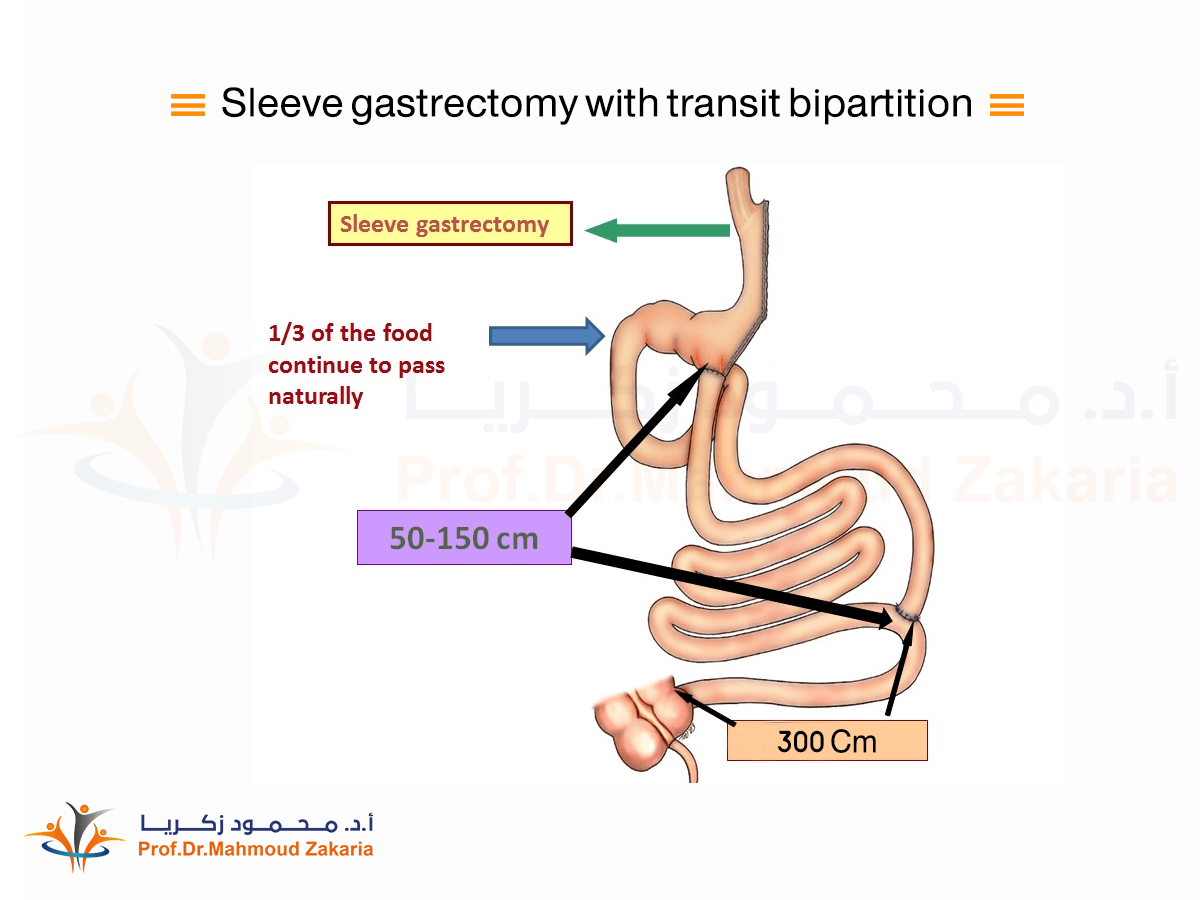Transit Bipartition
What is Sleeve Gastrectomy with Transit Bipartition?
In this operation, a sleeve gastrectomy is performed and 80% of the stomach is removed, including the dome of the stomach, which is the place responsible for the secretion of the hormone Ghrelin (responsible for feeling hungry) with making a connection between the stomach, and the small intestine and another connection between the small intestine and another part of the small intestine. The first person to prescribe Sleeve Gastrectomy with Transit Bipartition was the Brazilian surgeon Sergio Santoro.
The Sleeve Gastrectomy with Transit Bipartition operation reduces the amount of food and reduces the absorption of food. It also works to adjust the hormones of the digestive system to control the level of sugar in the blood so that it leads to the treatment of type 2 diabetes and high blood pressure. Sleeve Gastrectomy with Transit Bipartition operation reduces the level of cholesterol and fats in the blood.
What is the difference between the Sleeve Gastrectomy with the Transit Bipartition operation and the SASI operation?
In the SASI operation, a gastric sleeve is performed with only one connection between the stomach and the small intestine by the omega-loop Ώ method. In the Sleeve Gastrectomy with Transit, the Bipartition operation is characterized by preventing bile reflux after the operation, which is one of the possible complications after the SASI operation. Sleeve Gastrectomy with Transit Bipartition operation results are better than the SASI operation results in terms of weight loss and maintaining the ideal weight( prevent weight regain).
How does Sleeve Gastrectomy with Transit Bipartition operation cure type 2 diabetes?
The operation stimulates the secretion of very beneficial hormones GLP1 and PYY from the last part of the small intestine, which leads to:
– Increased secretion of the Insulin hormone from the pancreas.
– Reducing the anti-insulin hormone.
– Reducing insulin resistance of body cells (increasing insulin efficiency).
When is the laparoscopic sleeve gastrectomy performed?
- When the BMI is greater than 40 Kg/m2
- When the BMI is from 35 to 39.9 Kg/m2 one of the health
problems associated with obesity such as:
- Type 2 diabetes
- Sleep Apnea
- Fatty liver disease
- Hypertension
- High blood lipids
What are the benefits of using the Laparoscope in the operation?
1- Pain relief after the operation.
2- Reduces the length of hospital stay.
3- No visible wounds.
4- Faster recovery and return to normal life and work than traditional open surgery.
We also use the patient-controlled analgesia painkiller (PCA) device, which prevents pain and makes the patient’s recovery faster after the operation. PCA is a method of pain relief in which the patient controls the amount of pain medicine that is used. When pain relief is needed, the person can receive a preset dose of pain medicine by pressing a button on a computerized pump that is connected to a small tube.
How do you choose the best obesity surgeon for your operation?
The Sleeve Gastrectomy with Transit Bipartition operation is one of the complex operations that need to be performed by an experienced laparoscopic surgeon with long experience in performing laparoscopic obesity surgeries. The surgery should be performed by a modern laparoscope and staplers, so when you intend to have this surgery, we advise you to choose the right surgeon carefully.
How is the patient prepared for the operation?
Before surgery, you should give your doctor a list of all medications, vitamins, minerals, and herbal or nutritional supplements that you are taking. After surgery, you may have restrictions on eating, drinking, and the medications you can take.
If you take blood thinners such as Aspirin or Marivan, talk to your doctor before surgery. Since these medicines affect clotting and cause bleeding, you may need to change the routine of this medicine before the operation.
If you have diabetes, speak with your doctor for specific instructions on taking or adjusting your medication before and after surgery.
Smoking of all kinds must be stopped at least two weeks before the operation.
If you suffer from high blood pressure, blood pressure must be completely controlled before the operation, by regularly taking your medications and measuring blood pressure daily 1 week before the operation.

How long does the recovery take after the operation?
- The operation takes about 60 minutes.
- The patient is discharged from the hospital 24 hours after the operation.
- All patients are encouraged to walk as early as 3-4 hours after the operation. Most patients return to work and/or school one to four weeks after the operation. Fatigue is common in the first two weeks due to the decrease in calorie intake in the liquid diet phase. However, the majority of patients do not feel hungry during this phase of the diet. The energy level improves rapidly after the introduction of a soft diet, which takes about two weeks after surgery. We sometimes allow patients to work from home 2-3 days a week after surgery.
- You can start walking from 30 to 60 minutes a day after pain relief. Patients can start exercise and/or sports after two months of the operation.

